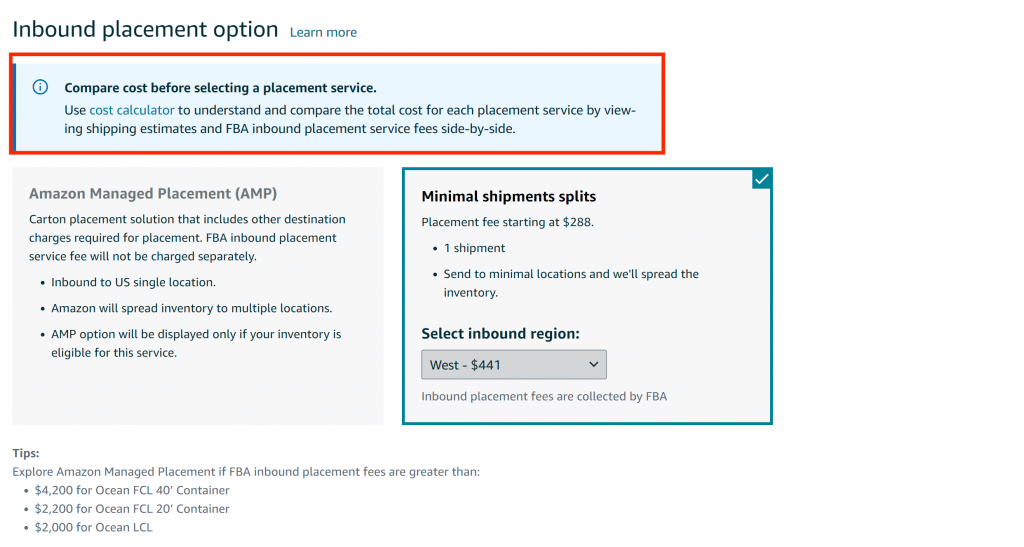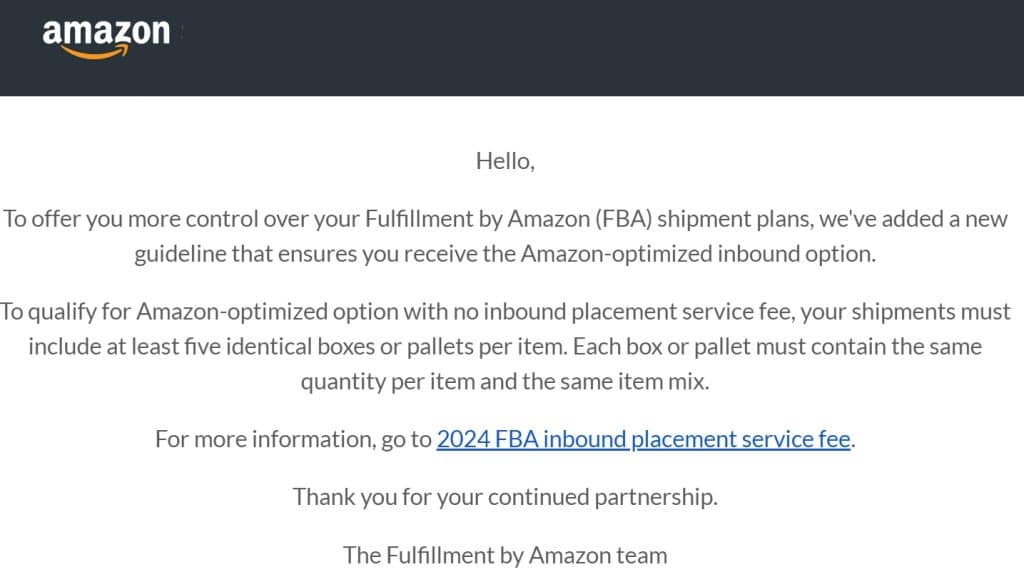How to Minimize Inbound Amazon Placement & Shipping Fees
Amazon introduced quite a few significant changes to its seller fees in 2024, making it even more expensive to sell on Amazon.
One of these new fees is the Inventory Placement Fee (or IPF) that took effect on March 1, 2024. The amount of increase varies, depending on the product, warehouse location, and other factors. But the good news is that you don’t always have to pay the fees.
In this article, we’ll explore the methods you can use to avoid or reduce your Inventory Placement Fee when sending products to Amazon.
Related Reading: Amazon Rolls Out Biggest and Most Complex Fee Increase Ever
What Are Amazon Inbound Placement Fees (IPF)?
The Inbound Placement Fee, also known as Inventory Placement Fee, is an amount Amazon charges to FBA sellers for not sending their products to more fulfillment centers. In a way, it’s like a penalty for sellers who send their products to only one or fewer locations as opposed to multiple fulfillment centers.
Amazon does this to encourage sellers to send their inventory to multiple inbound locations. The reason is obvious: it will take a shorter amount of time and will be less costly for Amazon to deliver your products if they’re spread out over multiple locations.
Distributing your shipments to more locations makes it easier for Amazon to deliver your products faster compared to keeping them in just a single or a few FCs.
When you create your shipment on Seller Central, Amazon will automatically show you the options you have as well as the fees. If you’re sending in only a few units, this is how your options will look like:
You won’t have the option for Amazon-optimized shipment splits and Partial shipment splits. You’ll only see the Minimal Shipment splits that lets you choose which inbound region you want to send to: East, West, or Central.
However, if you send enough products to Amazon, you will have more options that look like this:
Notice that for the Amazon-optimized shipment splits option, you will pay zero placement service fees. Typically larger shipments can result in lower inventory placement fees (but may also incur higher carrier fees – more on that later)
Take a look at the difference between the price of six and two shipments:
The placement fee for 6 shipments is significantly lower than that of the 2 shipments.
For the partial and minimal shipment options, you can choose which region to send to. This is mainly affected by the location of your warehouse.
How Inbound Placement Fees Are Calculated
Your placement service fees are calculated based on your product’s size tier (note that there are updated tiers in 2024), weight, quantity, and number of inbound locations you’re sending to.
Amazon provides us a quick reference for the expected fees:
Inbound Placement Fees for Standard-Size Products
Inbound Placement Fees for Large Bulky-Size Products
The final amount will show up when you make a shipping order, but these tables should give you an idea of how much you will be paying.
How to Avoid or Reduce Amazon's FBA Inventory Placement Fees
Most third-party Amazon sellers were livid when they found out about the new placement fees. However, there’s one piece of good news you have to remember at this point: You don’t always have to pay the Inventory Placement Fees.
So how do you go around the
Remember that if you send enough products to a lot of locations, then you can avoid the fee completely. However, as you will soon find out, the zero inbound placement fee option is not always the cheapest.
Tip #1: Always Do the Math and Consider Placement Fees PLUS Carrier Fees
If you don’t have a Google or Excel Spreadsheet to determine your per-unit price, then you’re probably spending more than you need to because here’s the thing: When you consider the cost of shipping, you don’t just go for the option with the lowest inbound placement fee. You should consider both the IPF plus the partner carrier fees.
The carrier fees also show up when you choose your shipment option:
Let’s illustrate how you would choose the best option by calculating the per-unit price.
In one of our shipments, our calculations look like this:
As you can see, the West is our cheapest option, and it becomes apparent when you calculate on a per-unit basis. The “no placement fee” option comes in second, but it’s still $0.14 more expensive per unit. And this is true for this particular brand 99% of the time.
So the next time you make your shipping plan, don’t just go immediately for no placement fee. Other options might be cheaper.
Tip #2: Use Amazon Warehousing and Distribution (AWD)
Using AWD is your easiest solution to avoid placement fees as placement fees don’t apply to shipments sent to AWD. Many sellers felt, in fact, that Inventory Placement fees was Amazon pushing sellers to use AWD
If this is your first time hearing about AWD, then you’re missing out on a lot of storage and shipment benefits.
AWD offers a cheaper storage solution for both FBA and non-FBA users.
We have a full article about AWD that you can check out.
However, there are other fees involved in lieu of the placement fee:
Again, you have to do the math here if you want to know which option is cheaper. You can create a table like this to know how long you can keep inventory in AWD to remain profitable.
Tip #3: Use AGL When You’re Importing from China
For those of you who import your products from mainland China and Hong Kong, you should really be using Amazon Global Logistics or AGL. However, using AGL alone likely won’t make you avoid inbound placement fees altogether.
Let’s discuss.
You have two options when you’re using AGL: Amazon Managed Placement (AMP) and Minimal Shipment Splits. The former will split your cargo into multiple shipments and you won’t be charged inbound placement fees. However, splitting cargo from China into multiple LCL shipments (or multiple full container loads) can result in a lot more fees within China (charges your suppliers may make you incur).
Subsequently, most sellers opt for Minimal Shipment Splits, i.e. shipping to one port along with the placement fees associated with this.
The AGL fees vary, depending on the following factors:
- Shipping mode
- City of origin
- Fulfillment center destination
When you're sending in shipment to Amazon, there's a cost calculator that you can use to estimate how much shipping and FBA inbound placement service fees are.

Ahh, and back to AWD. You won’t be charged placement fees for Amazon Global Logistics shipments going to AWD and you’ll get a discount off the base FCL/LCL shipping rates.
Tip #4 – Ship At Least 5 Identical Boxes
In August 2024 Amazon announced that “To qualify for Amazon-optimized option with no inbound placement service fee, your shipments must include at least five identical boxes or pallets per item”. What this means is that if we you sell t-shirts in 5 different sizes, you can't simply send in 1 box of each size. You need to send in 5 boxes with identical sizes. For people with lots of variations this is providing to be quite punitive. For example, if your XXXL yoga pants are a slow selling size, you either need pay big placement fees or send in too much inventory.

There's no ideal workaround to this but possible solutions are to either having smaller case-pack quantities (i.e. put 10 items in a master carton instead of 100) or mix cartons with different variations.
Consider a More Centralized Warehouse/3PL Location
One of the biggest losers from placement fees were people who had warehouses strategically located nearby to an Amazon FC. For example, we sold a business based in North Carolina that had the vast majority of shipments being shipped within the same UPS zone to nearby states such as Tennessee, and Indiana. After placement fees, we were now asked to ship these all over the country or pay placement fees. It rocked a margin-sensitive business.
A more centralized warehouse location such as Kentucky allows you to ship more cheaply to regions across the U.S. and also avoid placement fees. In this case, you need to do the math for the impact from placement fees, shipping to multiple locations, and increased ocean/rail freight rates inbound to your warehouse/3PL.
How Much More are Placement Fees Really?
So how much more do placement fees actually cost?
We looked at a handful of our SKUs and calculated how much the placement fees were and how much the associated FBA fee decreases were. It can be difficult to calculate the true impact as there’s a lot of variables, i.e. the selling price of an item (a $0.25 fee decrease means less on a $200 product than a $20 product), the location of our 3PL, where items were typically being shipped to pre-placement fees, etc. However, we were able to determine some clear winners/losers:
- Items shipped from our Washington State 3PL saw net fee increases of just $0.00-$0.14.
- Standard size items shipped with AGL saw increases of $0.21 per unit
- Large Bulky Items shipped with AGL saw increases of a whopping $1.86 to $4.28 per unit
Clearly, the big losers are large bulky items shipped with AGL (especially given the fact AWD does not currently support Large Bulky).

Conclusion
Selling on Amazon has become more expensive in 2024, especially with the implementation of the new fees. But as with anything else related to business, the key is to do the math and compare your options using actual numbers from your brand.
Have you tried any of these IPF workarounds? Share your thoughts in the comments section below.



